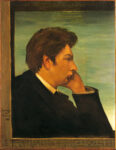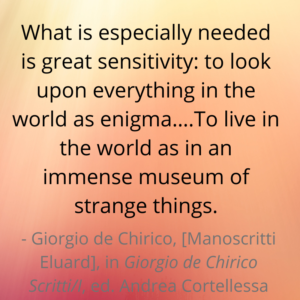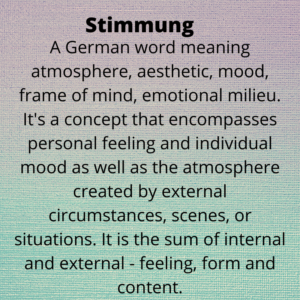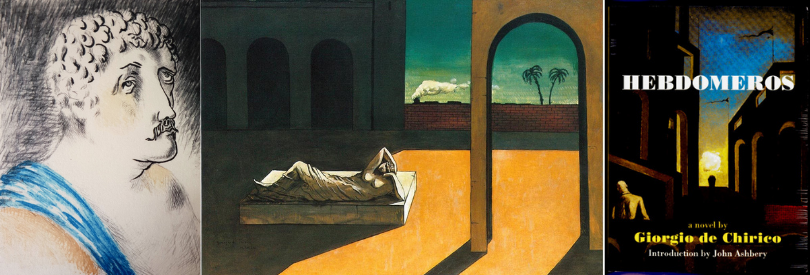
Digging into the women writers of WW2
led me to the short stories of
Anna Kavan
whose life and work brought to mind
Gertrude Abercrombie
whose art is often said to be influenced by
Giorgio Di Chirico
who wrote what
John Ashberry
called the first surrealist novel
– Hebdomeros –
that some have compared to Anna Kavan’s novel
Ice
that captured my imagination
and so to complete the chain
I had to read
Hebdomeros
and so I did.
That’s it for the introductory name-dropping.
Before I get to de Chirico’s 1929 novel – and to set the psychological scene – let’s take a look at a few early de Chirico paintings:

There’s masses of art commentary online so I’m not going to replicate any of it, especially as my knowledge is so rudimentary.
Rather, I’ll ask a question and try to answer it.
Question
 What is the accumulated Stimmung of these paintings?
What is the accumulated Stimmung of these paintings?
And Answer
Reality is off-kilter and out of alignment. An eerie sense of dislocation as surfaces are angled in impossible ways that defy logic. Objects appear as if at random. It is at once both familiar and very strange. Time seems distorted with classical statues and Roman arches and Italian architecture and a train chugging along in the background while a ship sails beyond the wall. When is this? Where is this? Looming shadows and distorted perspectives create a sense of foreboding, of something sinister about to happen. Figures are isolated in wide empty spaces and nothing much happens. Yet. And what about those bananas? How did they get there? What does it mean? What can it possibly mean? And what’s with the empty wagon? What can that portend? If the scene is so calm why does it disturb? If it seems familiar why does it seem mysterious and strange? What’s the puzzle of double vision and the two halves? What is the significance of these odd juxtapositions and where have all the people gone? These bright cityscapes bereft of crowds are unsettling. When is this? Where is this? I feel displaced.
And so to Hebdomeros and the German Consulate in Melbourne
The novel opens begins in the middle of something and a visit to a building:
…And then began the visit to that strange building located in an austerely respectable but by no means dismal street. Seen from outside, the building looked like a German consulate in Melbourne. Large shops took up the whole ground floor. Though it was neither a Sunday nor a holiday the shops were closed at the time, which gave to this portion of the street a weary, melancholy air, that particular dreary atmosphere one associates with Anglo-Saxon towns on Sundays. A faint smell of docks hung in the air, the indefinable and highly suggestive odor given off by warehouses adjoining the wharves in a port. The idea that the building resembled a German consulate in Melbourne was a purely personal one of Hebdomeros’, and when he spoke about it to his friends they smiled and said they found the comparison odd, but they immediately dropped the subject and went on to talk about something else. Hebdomeros concluded from this that perhaps they had not really understood what he meant, and he reflected on the difficulty of making oneself understood when one’s thoughts reached a certain height or depth.
Hebdomeros – our hero – has never been to Australia nor had de Chirico. But we are off and running.
“It’s strange,” Hebdomeros was thinking, “as for me, the very idea that something had escaped my understanding would keep me awake at nights, whereas people in general are not in the least perturbed when they see or read or hear things they find completely obscure.
They began to climb the stairs,… Hebdomeros felt as though he were going upstairs to visit a dentist, or a doctor specializing in venereal diseases; this perturbed him a little, and he felt the onset of something like the colic; he tried to fight down this uneasiness by reminding himself he was not alone, that two of his friends were with him — strong, athletic fellows carrying automatics with spare magazines in the pockets of their trousers.
An interesting and possibly fairly conventional start to a novel plus a few odd bits. But wait…no settling into character and plot. We are entering the world of de Chirico’s metaphysical paintings and nothing is quite logical. We are entering a world of contradictions, dense with detail and full of shifts of time and place. It is a dreamscape that carries you forward by the power of images. It is like being held in a soundless film and the projectionist keeping switching reels and changing speeds.
The scene shifts to childhood dreams; to the noise his father’s shoes made; to a gaming room in Monte Carlo; to the enigma of the Roman gladiators and blood-soaked sand of the Roman arena; to a grand piano in a drawing-room beneath a chandelier laden with blue and pink wax candles. What would happen to the entrails of the piano if the chandelier were to fall?
Episodes, anecdotes, and recollections assembled like a collage with no regard for narrative sequence. Long, stream-of-consciousness, run-on sentences pile on the images strung together by semi-colons. The constraints of time and space are abandoned.
Our hero Hebdomeros imagines and remembers past experiences. He opines on food – considered strawberries and figs the most immoral fruits – and excoriates fashionable artists – “the living and walking symbol of human stupidity”. He has opinions and, like de Chirico himself, suffers from colic. It’s all a bit down the rabbit hole with Lewis Carroll.
Dreamlike and mysterious, the novel creates a poetic version of the strange world of de Chirico’s paintings. It’s no wonder that John Ashbery was a fan and translator. If you are interested in his view listen to his lecture:
John Ashbery Lecture on Giorgio de Chirico at the Poetry Project, NYC, March 22, 1979
part one (38:17): MP3
part two (30:28): MP3
Extracts:
Having left the town, Hebdomeros stopped in a valley which lay a short distance away from the highest mountain rising in the east. At any moment he was to begin a long nocturnal climb and needed to gather his strength, so he sat down on a stone where he had first placed his carefully folded coat and plunged into deep thought; slowly, with each memory from the past, the curtain rose. Hebdomeros abandoned himself happily to this nostalgia; it was one of his principal weaknesses always to have a certain nostalgia for the past, even for a past that had been completely fulfilled; that was why he liked also to sleep in the afternoon; he maintained that nothing evokes memories of the past so profoundly as the moments before or immediately following the afternoon nap.
It’s a book you dwell in and leave and return to. Episodes come into focus and fade away as the scene pans to another moment – another Stimmungswechsel, or atmospheric shift.
Then one could return? The carriage would drive swiftly away, drawn by its five trotting horses and closely followed by a cavalry detachment; all day long under the sun and at night on the great black mountain like a stranded whale that huge man, that hero stretched out on the summit would lie awake watching the stars. Where are you, children? Hebdomeros is in love with Louise, the maid in the house across the way; he has put on his new suit; the bells are ringing in the steeples of the parish churches and the springtime smiles in the kitchen gardens. Springtime, springtime! Funeral procession, macabre vision. Corpses in dinner jackets laid out in their open coffins are lined up on the beaches of the south; one can catch the haunting smell of lemon which, like garlic and onion, renders dishes indigestible; here are the oranges with the unavowable symbols of their obscene flowers. Where are you going, man whose coat is trimmed with an astrakhan collar? Prototype of the great traveler, ready to defend the sick child threatened by the bandits’ rapacious hands in the train stinking of wet cattle in the August shower? Where are you going, helmeted warrior with shifty eyes? Heart of steel at the windows open on towns that cling like vultures’ nests to the rocks, where the innkeeper, thirsty for lucre, points out for you with a sweep of his red hand the vast panorama of the valley, crossed at its center by the river, sometimes opaque, sometimes gleaming, like the life of man.
Must one for all that renounce one’s seat and, when one has paid for a first-class ticket, obstinately remain in second despite the conductor’s gentle insistence? But it is a lake as vast as the sea and which, like the sea, has its dangerous fits of temper; beware of drowning then, and when the motorboats hasten to your rescue you will know, then, what it means to be reborn in that summer afternoon where the sidewalks, bathed by the shower, reflect the lights in the shop windows so faithfully that you would think yourself in Venice; and that charming city built in tiers around the lake.
In an Éluard-Picasso manuscript de Chirico wrote: “Live in the world as in a huge museum of oddities, of curious multicolored toys that change appearance, and that, like children, we sometimes break into pieces to see what they are like inside, and discover in disappointment that they are empty”.
And later “There is no point in talking about history or the causes of this and that; all this describes but explains nothing, for the eternal reason that there is nothing to explain, and that the enigma always remains”.
Bottom Lines
Hebdomeros is disorienting, compulsive, mesmerizing, and compelling
Would I recommend it? No.
Does it have significance? Who knows?
Is it all a hoax and basically meaningless, pretentious twaddle? Possibly. You decide.
Did you enjoy it? Yes.
Will you read it again? Yes.



New one for me. Thanks for highlighting it. I found a link to a copy online. Going to give it a try.
Poetry, that strange thing that people do when they feel they have something to say that is not one of the things everyone else has already said.
Nia Hayes – ShunCy´s last blog post ..How to Grow Jackfruit
Hey, I loved your blog please visit mine and support it you like 🙂 https://chicadecampo.wordpress.com/
I think I would give it a go if I had time —
But alas, a lack thereof….ergo I rhyme.
World enough but not of time
Your “failure” then is no crime.
de Chirico’s work – after all –
Is not an undertaking small.
Your time, as it always has,
Is better spent on music and on jazz.
(Not to mention all your other useful and valuable blogging attributes.)
Intriguing. And I’m tempted.
Apparently, it matters which translation you read. John Ashbery seems to be the preferred version but then there’s a whole other story about that too. (Who’s hoaxing whom?)
Most seem to say avoid the Margaret Crosland.
All that aside – I am a fan!
De Chirico loved his empty plazas and often included some enigma. Should we accept the bananas just as they appear, or should we question why, and isn’t stimmung just the perfect word to describe why we should not be overly concerned one way or the other? Great post Josie.
Thank you! Wonderful post – I may have to track down a copy!
What a stunning piece! I have always loved the strangeness of de Chirico (and Gertrude Abercrombie) but had no idea he had written a novel. I don’t care if it’s twaddle. I will read it.
Agree on the artists and especially de Chirico. And great pairing with Ashbery. (Sylvia Plath was also a fan and wrote several ekphrastic poems based on his paintings.
This had me smitten from the get-go: “Seen from outside, the building looked like a German consulate in Melbourne.”
I was never in 1920s Melbourne either (not any other decade for that matter) but somehow I have a very clear sense of the building even though we actually are not told what it looks like.
I actually googled it. Quite a dull looking building in Queen Street a fairly boring street of offices.
I did too! Looks like the consulate is in a building that could be in any big city.
But …1929 and de Chirico’s mind – had more specific – but also rather dull – associations.
I was going to include a pic (because I was so taken by the concept.)
I suppose Melbourne was the dullest place he could think of.